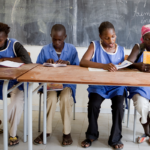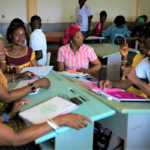By: Fernanda Soares (FHI 360), Anne Smiley (FHI 360) & Daniel Lavan (ECCN)
A solid consensus emerged within the global education community over the past decade on the imperative of improving equity of education access. The newly released USAID Education Policy (2018) calls for promotion of equity and equal access to quality education as a priority area, with a particular focus on increasing access among the most marginalized and vulnerable children and youth. Crisis and conflict settings face a peculiar challenge, as they tend to have overall lower education access rates and are characterized by the largest disparities in access as a result of exclusion by poverty, gender, displacement, urban/rural residence or other factors (EPDC, 2007). As a result, education programming should prioritize equitable approaches to education access in such settings while also measuring change in equitable access over time.
A 2016 analysis of indicators used in USAID Goal 3 projects conducted by the USAID Education in Conflict and Crisis Network highlights that many projects measure equity simply by disaggregating indicators on access or retention by one or more dimensions of equity, most often by gender. Simple disaggregation, however, assumes that increased equity may improve over the lifecycle of the intervention – rather than explicitly and purposefully designing context-specific equity strategies and intervention components that will be measured by the program. While disaggregation of education access or retention can provide useful information on differences by population subgroups, it does not inform the extent to which access or retention gaps between the subgroups are narrowing (or increasing) over time. Therefore, including explicit equity indicators in a program monitoring and evaluation plan shines a light on education equity as a core program outcome, thus increasing the likelihood that education equity will be prioritized.
An equitable access indicator measures change in access to education among population subgroups or the narrowing of access gaps between subgroups. Inequalities in education often coincide with group boundaries, as children from the poorest and most marginalized segments of the population tend to suffer disproportionately higher levels of exclusion from the education system. Equitable access indicators measure horizontal inequalities – that is, inequalities among different groups in a society.
In the guidance document, we propose a general sequence for developing, measuring and monitoring customized indicators of equitable education access. The emphasis on customization comes from recognizing that the patterns of exclusion and education inequity vary by country and locality. Customized indicators allow for flexibility and adaptation to the needs and objectives of specific projects. Here are our six steps.
Step 1: Identify relevant equity dimension(s)
Measuring equitable access entails understanding how children’s background characteristics and their group affiliations shape their access to educational opportunities. So, in the first step, we: 1) identify the vulnerable population subgroup(s) most likely to include out-of-school children and youth who are at risk of sporadic attendance and/or dropping out, and 2) define the individual and group background characteristics (or equity dimensions) of these excluded children. Once these equity dimensions are identified, we build a profile of these children and youth to help identify the types of barriers they face in accessing education or staying in school. To the extent possible, step one should be embedded and fully integrated into initial educational needs assessments and situation analysis as well as into rolling assessments. For example, it can be conducted as part of a Rapid Education Risk Analysis (RERA), which is a rapid, “good enough” situation analysis that integrates education assessment, conflict analysis, disaster risk assessment and resilience analysis.
Step 2: Define intervention
In the second step, we aim to identify which intervention might prove useful in promoting increased access to education based on the equity dimensions and barriers identified. We developed a matrix that indicates which intervention or set of interventions are most suited to targeting and promoting school access and/or retention among the specific population subgroup(s) most likely to include out-of-school children. Our matrix, available here, can inform project designers’ selection of specific interventions based on the context-specific equity dimensions, barriers and zones of exclusion that the project identified.
Step 3: Develop equitable access indicators
After identifying the key equity dimensions and the corresponding intervention to promote increased access, we can take the third step: develop equitable access indicators that measure the extent to which equitable access is improving over time.
First, we choose the basic access/retention indicators for customization based on the specific access and retention objective(s) of the project. For example, a project that aims to promote first-time school entry may want to focus on intake rates. Next, we plug the equity dimension identified in step one into the indicator formulation. And finally, we choose an equity metric.
For the purposes of monitoring a project’s progress and measuring its effect, we recommend the use of metrics known as gap ratios or parity ratios, as they may represent the easiest, most intuitive and relevant measures for calculating inequality. Gaps and parity indexes compare two groups with distinct levels of educational access. For equity dimensions that involve three or more groups (e.g., ethnicity, religion and/or language), gap and parity ratios can be applied to compare different groups of interest (not necessarily the two largest), to compare disparities between one dominant group and other minority groups combined, or between a given group and the national education access average.
In the table below, we offer a practical example for how to formulate an equitable education access indicator.
| Access– retention measure | Equity dimension | Equity metrics | Indicator | Formula |
|---|---|---|---|---|
| Gross intake rate | Displacement (IDPs, refugees, asylum seekers) | Gap | Gaps in primary-level gross intake rate by displacement status | (Number of non-repeating host community students in primary Grade 1 / Host community population of the theoretical age of primary Grade 1) x 100 - (Number of non-repeating forcibly displaced students in primary Grade 1 / Forcibly displaced population of the theoretical age of primary Grade 1) x 100 |
Step 4. Conduct data inventory and quality assessment
Next, we recommend that projects conduct a detailed inventory of all existing data sources relevant to calculations of school access and retention indicators as well as a data quality assessment. Crisis and conflict-affected contexts often face challenges in information management and measurement related to the availability or reliability of data. To support projects in their data inventory, the guidance document provides a list of traditional data sources and population projections to consider as well as of potential humanitarian and other organizations who often apply alternative methods to estimate reference population numbers, which are needed to calculate school access.
Step 5. Conduct primary data collection, as needed
In the fifth step, we collect primary data. Based on the results from the data inventory and data quality assessment, primary data collection might be needed to fill any gaps.
Where population data are available (either from national census and/or subnational data from other organizations), but administrative-school data are not, calculating access indicators requires collecting data at the school level to obtain information on the number of enrollments by age, grade and relevant population subgroups.
Where no data is available, if feasible, projects may conduct household surveys to monitor school access for each of the groups of interest. In the guidance document, we highlight household survey sampling methods that are designed with the purpose of improving access to hard-to-reach populations and that enable project monitoring and evaluation staff to collect data on previously identified marginalized population subgroups.
We stress here that it is essential for any primary data collection to be conducted in a conflict sensitive manner that adheres strictly to the Do No Harm principle. Of particular concern in these situations is ensuring the confidentiality and security of data on individuals’ identity group membership (such as ethnicity or displaced person status). We recommend consulting the USAID Checklist for Conflict Sensitivity in Education Programs, as well as the INEE Conflict Sensitive Education Pack.
Step 6. Calculate equitable access indicators continuously
Once steps one through five are in place, we can then calculate equitable access indicators on an ongoing basis. Dissemination of this information to appropriate audiences, including local communities, education authorities, donors and other key local stakeholders, can help galvanize support and engagement for discussions around equitable access to educational opportunities. In addition, dissemination of findings on indicator performance to key stakeholders during the project’s annual work planning process can help spur discussion and reflection as well as the incorporation of those findings into improved programming.
The six-step process outlined above – detailed in the guidance document – helps develop customizable equitable access indicators for individual projects. Although the guidance is applicable to developing countries in general, it attempts to address education access challenges and data availability issues specific to crises and conflict settings.
This post is cross-published on the USAID ECCN blog.
A collaboration of the USAID Education in Crisis and Conflict Network (ECCN) support team and the Education Equity Research Initiative produced the guidance document.
Photo caption: Students attend school in rural Kinding Ndjabi, Cameroon
Photo credit: © 2015 Nathan Kaemena, Courtesy of Photoshare



